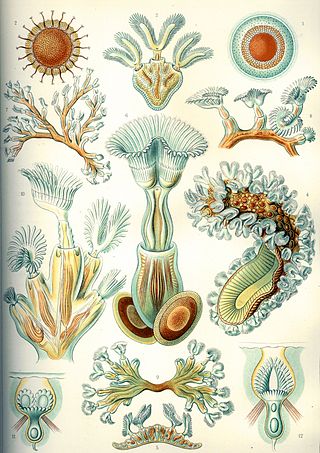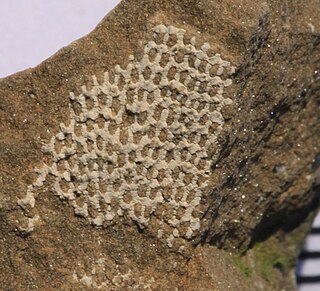
Bryozoa are a phylum of simple, aquatic invertebrate animals, nearly all living in sedentary colonies. Typically about 0.5 millimetres long, they have a special feeding structure called a lophophore, a "crown" of tentacles used for filter feeding. Most marine bryozoans live in tropical waters, but a few are found in oceanic trenches and polar waters. The bryozoans are classified as the marine bryozoans (Stenolaemata), freshwater bryozoans (Phylactolaemata), and mostly-marine bryozoans (Gymnolaemata), a few members of which prefer brackish water. 5,869 living species are known. Originally all of the crown group Bryozoa were colonial, but as an adaptation to a mesopsammal life or to deep-sea habitats, secondarily solitary forms have since evolved. Solitary species has been described in four genera;. The latter having a statocyst-like organ with a supposed excretory function.
Stenolaemata are a class of exclusively marine bryozoans. Stenolaemates originated and diversified in the Ordovician, and more than 600 species are still alive today. All extant (living) species are in the order Cyclostomatida, the third-largest order of living bryozoans.

Trepostomatida is an extinct order of bryozoans in the class Stenolaemata. Trepostome bryozoans possessed mineralized calcitic skeletons and are frequently fossilized; some of the largest known fossilized bryozoan colonies are branching trepostomes and massive dome-shaped trepostomes. Trepostomes did not have many specialized zooecia beyond ordinary feeding autozooecia. The two main known heteromorphs are exilazooecia and mesozooecia, which had the purpose of maintaining regular spacing between autozooecia.
Helen Margaret Duncan was a geologist and paleontologist with the United States Geological Survey from 1945 to 1971, where she worked in the Paleontology and Stratigraphy Branch. Duncan was considered one of the strongest women in the Cincinnati geology department; her contributions to the Lipalian Research Foundation and the Pick and Hammer shows were additional work of her time. Duncan paved the path for many geology scholars to follow with her discoveries on fossil records and her studies in paleontology and stratigraphy.
Fenestrata is an extinct order of bryozoan, dating from the Upper Arenig. Most fenestrate bryozoans formed net-like colonies, often in funnel- or fan-shaped forms, with a single layer of zooids facing one direction. The colony shape served as a filter-feeding apparatus that water currents flowed through, with autozooecial apertures only on the side of the colony facing into the current. This colony structure was vulnerable to predators, so some fenestrate bryozoans produced skeletal superstructures, likely to strengthen or protect the colony, and others had protective spines surrounding their autozooecial apertures.
Ceramopora is an extinct genus of bryozoan of the family Ceramoporidae. It is one of the earliest genera of bryozoans. Its colonies were thin and discoid, with large autozooecia, abundant communication pores, lunaria, and monticules with depressions in their centers. It had no acanthostyles or diaphragms, distinguishing it from Acanthoceramoporella.

Fenestellidae is a family of bryozoans belonging to the order Fenestrida. The skeleton of its colonies consists of stiff branches that are interconnected by narrower crossbars. The individuals of the colony inhabit one side of the branches in two parallel rows or two at the branch base and three or more rows further up. Zooids can be recognized as small rimmed pores, and in well-preserved specimens the apertures are closed by centrally perforated lids. The front of the branches carries small nodes in a row or zigzag line between the apertures. Branches split from time to time giving the colonies a fan-shape or, in the genus Archimedes, create an mesh in the shape of an Archimedes screw.
Marcusodictyon is a genus of problematic fossils. It has been considered the oldest bryozoan in several publications. Taylor (1984) revised the systematics of the genus and removed it from Bryozoa. The fossil constitutes a phosphatic network of low ridges that enclose polygons about 0.3–1.2 mm wide that are generally 6-sided but can be 4-, 5- or 7-sided. The internal microstructure of Marcusodictyon is composed of laminae parallel to external surfaces of ridges. Marcusodictyon occurs on late Cambrian and Tremadocian lingulate brachiopods of Baltica.
Paleontology or palaeontology is the study of prehistoric life forms on Earth through the examination of plant and animal fossils. This includes the study of body fossils, tracks (ichnites), burrows, cast-off parts, fossilised feces (coprolites), palynomorphs and chemical residues. Because humans have encountered fossils for millennia, paleontology has a long history both before and after becoming formalized as a science. This article records significant discoveries and events related to paleontology that occurred or were published in the year 2015.
Rhombopora is an extinct genus of bryozoa. It existed from the Ordovician to Permian period.
Septopora is an extinct genus of bryozoan belonging to the order Fenestrida. It has been found in Pennsylvanian to Permian beds in North America, South America, Australia, and southwest and east Asia.
Acanthoceramoporella is an extinct genus of cystoporate bryozoans from the Ordovician period.
Orectodictya is an extinct genus of ptilodictyoid bryozoans known from Ordovician fossils found in the U.S. state of Kentucky. It is monotypic, containing the single species Orectodictya pansa.
Monticulipora is an extinct genus of Ordovician bryozoans belonging to the family Monticuliporidae. It was first named in 1849, and its description was published the following year by French paleontologist Alcide M. d'Orbigny, making it one of the earliest bryozoans to be recognized in science. It is still one of the most widespread fossil bryozoan genera. Though colonies that grow in masses made of multiple layers are characteristic of the genus, its colonies have varying shapes, able to be encrusting, branching, massive, or frond-like, and are covered in monticules (bumps). Most Monticulipora species have distinctively granular walls, and Monticulipora and can be distinguished from Homotrypa by the presence of axial diaphragms.
Homotrypa is an extinct genus of bryozoans from the Ordovician and Silurian periods, known from fossils found in the United States. Its colonies are branch-like and have small monticules made of groups of three or four larger zooecia slightly protruding out from the main surface of the colony. In cross section, the zooecia are erect in axis and gently curve toward the surface of the colony.
Mesotrypa is a genus of bryozoans known from the Ordovician period, first described in 1893. Its colonies consist of low masses, wider than they are thick, made of superimposed layers, with small monticules on the surface of the colony.
Eridotrypa is an extinct genus of bryozoans of the family Aisenvergiidae, consistently forming colonies made of thin branches. Diaphragms are very common in colonies. Distinctively, in the exozone there are serrated dark borders separating the autozooecia.
Prasopora is an extinct genus of bryozoan belonging to the family Monticuliporidae, known from the Middle Ordovician. Its colonies were disc-shaped or hemispherical, flat on bottom and convex on top, and had very abundant mesopores; in the case of the species P. insularis its zooecia were isolated from each other by the numerous mesopores surrounding them. It is very similar to the genus Monticulipora, and some bryozoan species have been assigned to both genera at different points in their study, but it is mostly distinguished by having more mesozooecia, rounder autozooecial apertures, relatively few acanthostyles and diaphragms and cystiphragms equally distributed in the autozooecia.
Pharopora is an extinct genus of bryozoan of the family Rhabdomesidae that lived in the Mississippian period. It is characterized by colonies with branches possessing regular internodes and articulating cone-shaped terminations. It is the first genus of bryozoan in the family Rhabdomesidae with articulated (jointed) parts in its colonies.
Arthrostyloecia is an extinct genus of bryozoan of the family Arthrostylidae, that lived in the Ordovician period. Its colonies are articulated, distinctively containing ball and socket joints. It contains a single species, Arthrostyloecia nitida.


